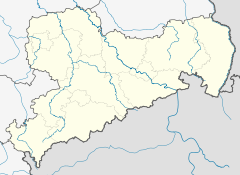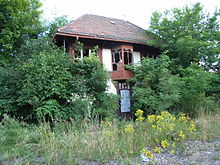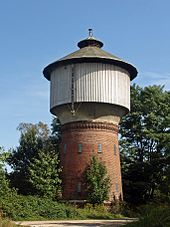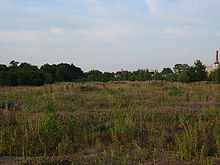Schlauroth Gbf station
| Schlauroth Gbf | ||
|---|---|---|
|
|
||
| Data | ||
| Operating point type | former train station | |
| opening | November 1, 1909 | |
| Conveyance | January 10, 1994 | |
| location | ||
| City / municipality | Goerlitz | |
| Place / district | Clever red | |
| country | Saxony | |
| Country | Germany | |
| Coordinates | 51 ° 9 ′ 0 ″ N , 14 ° 56 ′ 0 ″ E | |
| Height ( SO ) | 232.8 m above sea level NN | |
| Railway lines | ||
|
||
| Railway stations and stops in Saxony | ||
| Görlitz – Junction Schlauroth | |||||||||||||||||||||||||||||||||||||||||||||||||||||||||
|---|---|---|---|---|---|---|---|---|---|---|---|---|---|---|---|---|---|---|---|---|---|---|---|---|---|---|---|---|---|---|---|---|---|---|---|---|---|---|---|---|---|---|---|---|---|---|---|---|---|---|---|---|---|---|---|---|---|
| Route number (DB) : | 6213 | ||||||||||||||||||||||||||||||||||||||||||||||||||||||||
| Course book section (DB) : | - | ||||||||||||||||||||||||||||||||||||||||||||||||||||||||
| Route length: | 4.45 km | ||||||||||||||||||||||||||||||||||||||||||||||||||||||||
| Gauge : | 1435 mm ( standard gauge ) | ||||||||||||||||||||||||||||||||||||||||||||||||||||||||
| Route class : | CM4 | ||||||||||||||||||||||||||||||||||||||||||||||||||||||||
| Power system : | 1922-1945: 15 kV 16.7 Hz ~ | ||||||||||||||||||||||||||||||||||||||||||||||||||||||||
|
|||||||||||||||||||||||||||||||||||||||||||||||||||||||||
The Schlauroth Gbf station was the central marshalling yard in the Görlitz railway junction until 1994 . It was named after the Schlauroth district of the city of Görlitz .
location
The station was north of the Dresden – Görlitz railway line and west of the line from Berlin on the Girbigsdorfer Flur. However, the marshalling yard got its later name Schlauroth marshalling yard or Schlauroth marshalling yard based on the nearby Schlauroth stop , which had existed since 1891 . The Schlauroth railway depot and the later Schlauroth test facility were also located on the site .
Connection
The marshalling yard was connected to the Görlitz station via the freight railway. The freight railway ran largely on the old Görlitz – Dresden line. To the east of the freight station, a connecting line from the Svt junction joined the freight railway, connecting the freight railway with the Berlin – Görlitz line. The freight railway also connected the Schlauroth depot and later also the test center for the automatic central buffer coupling to the railway network. The freight railway merged with the Görlitz – Dresden railway line to the west at the Swt signal box (later the B 6). After the Second World War, the second track along the freight railway was also dismantled. After the closure of the marshalling yard in Schlauroth, most of the track systems were dismantled. Only the connection from the former test center to the train station is still active.
Emergence
With the rapid increase in passenger and freight traffic around the turn of the century, the need for an expansion of the railway facilities around the Görlitz station grew in Görlitz . However, since the area was already surrounded on all sides by residential buildings, there was no possibility of expanding the facilities on site. So you had to look for other solutions. The first proposal was to build a freight yard at the Leschwitz suburban train station (today the Görlitz – Weinhübel stop ), as it was close to the developing industrial sites in Görlitz's southern part of the city and in Leschwitz (today: Weinhübel ). Due to the difficult terrain on the vineyard and the extensive leveling work and earthfill in the area of the station, the design was soon put aside. Now the planners noticed the area west of the urban area, it offered a large, flat area that was needed for a modern marshalling yard.
The design for the station from 1903 was, as usual, made available for inspection and implemented in the following years without any major changes. The plan also envisaged the interruption of numerous routes between Schlauroth, Rauschwalde and Girbigsdorf and the relocation of the road to Bautzen (today: Görlitzer Strasse). The road used to cross the railway line to Dresden at the level of the Gasthof Zur Eisenbahn (where Dorfstraße joins Görlitzer Straße) and was now laid in a wide western arc and from there crossed under the railway line at the level of the junction to the marshalling yard from the Dresden line. In 1906, the leveling work began for the shunting tracks, the laying of the Dresden – Görlitz line and the construction of a bridge on Rauschwalder Strasse. The cost of the entire system was around 4.5 million marks.
On October 22nd, 1909 the police acceptance of the project took place. The ambassadors of the state government from Liegnitz, government councilor Grosse and construction councilor Mylius, as well as the railway, the royal railway construction and operations inspector Büttner from Görlitz and construction inspector Lippmann from Breslau , attended the acceptance. The municipal magistrate was established by the city councilors Wallis and Herzog as well as the city planning officer Dr.-Ing. Sexton represented. Numerous private individuals also took part, some of whom raised their objections, such as B. too steep inclines of roads or the feared impassability of the Schlaurother railway underpass due to continuous rain. Since no serious defects were found, the station was able to open as planned on November 1, 1909. In the Görlitzer Anzeiger the following advertisement was already placed on October 20th: “On November 1st, 1909 the Schlauroth stop will be opened for goods traffic. It is authorized to handle freight, general cargo and wagon loads. [...] Schlauroth is subordinate to the factory inspection 1, the traffic inspection and the machine inspection in Görlitz as well as the workshop inspection in Lauban . "
Track systems
Three sidings led to the marshalling yard. From the west at the level of the road underpass in Schlauroth to Bundesstraße 6 there was an entry and exit to and from the railway line to Dresden. A single-track route branched off from the Berlin-Görlitzer-Eisenbahn in the north, which led under two overpasses and through a cut into the marshalling yard. The third siding ran on two tracks from Görlitzer Bahnhof over the former route of the Saxon-Silesian Railway and crossed the Berlin route on a box girder bridge. At the end of 1909, around 30 kilometers of track (with entrances and exits) had already been laid. The maximum extension of the track system with 32 kilometers was reached in the 1930s. In places up to 32 tracks lay next to each other. According to the traffic flows, the station was divided into different shunting districts, called groups.
Shunting districts / groups
The group A enclosed the tracks on the north side at Stadtgrabenweg that Einfahrgleise from the direction of Berlin , Görlitz, Kohlfurt , Lauban, Seidenberg and Zittau , the Ausfahrgleis to Berlin, the drive-through track for remote freight trains and the Abdrückgleis for the hump A. Group B consisted of eleven tracks in the central area of the marshalling yard, the shunting tracks for local freight to Görlitz, transitional freight and the reloading track with a manually operated overhead crane. The Group C were five tracks in the northern part of the central half and the directional assigned in and driving to Dresden and Berlin. For Group D nine tracks included on the northwest side of the station, these were the station tracks for Nahgüterzüge towards Berlin and Dresden. The group E were assigned to three tracks on the southern side at the level of the holding point Schlauroth, including the Einfahrgleise from Dresden and the headshunt from Ablaufberg E. The twelve direction and driving out to Görlitz, Kohlfurt, Lauban, Seidenberg and Zittau in the central eastern part the group F allocated. Group G again enclosed the last part of the station on the Dresden line in Rauschwalde with eight butt tracks for station shunting and the pull-out track for drainage mountain F.
Mention should be made here of the separate Schlauroth goods loading point with a loading track, storage areas, loading lane, track scales and a ramp built around 1911 in the north-western part of the D-Gruppe.
In 1946, numerous tracks were dismantled for reparations payments to the Soviet Union . Among them were u. a. the south-facing track of the freight train route to Görlitz, the entire group G and parts of groups A, C and F (a total of 11 kilometers). In 1948 two more tracks followed for the construction of the SDAG Wismut in the Ore Mountains .
Buildings & facilities
Until 1920, the marshalling yard, like the Schlauroth depot, formed a link between the Prussian State Railways and the Royal Saxon State Railroad . In this way, separate offices for officials and other buildings were created for each railway administration. In the station building across from Helmut-von-Gerlach-Strasse the head of the station was sitting with his administration. The three-storey houses flanking the main building served as residential buildings with overnight rooms for foreign train attendants, with the eastern house belonging to the Prussian state railroad and the western one to the Saxon state railway. After 1945, numerous Silesian refugees were also accommodated in them. Later in the 1950s, this was used to create apartments for railway families.
The five guard and two marshalling interlockings ensured safe and smooth operation. All signal boxes were two-storey, with the mechanical levers for switches and signals, which were manufactured by Müller & May in Rauschwalde in 1909 , were on the upper storey . On the ground floor, however, was the tensioning room with tension weights and pulleys for the wire rope hoists to the signals and points. Each building, including the signal boxes and the flat houses for train dispatchers and shunters, had its own separate small outhouse. The first designation of the signal boxes corresponded to the usual abbreviation for the place name and the compass direction or the location. B. Snt for Schlauroth north tower. It was the largest central signal box at the time and, like all the others, was renamed in 1960 to W 2 (guard signal box and headquarters of the station dispatcher). From Swt B was 6 (Command signal box) and from Sot B 1. Here the station dispatcher was located. The guards interlocking W 5 was formerly Snwt (Schlauroth north-west tower). The technical staff had set up their service and social rooms in the former central tower Smt . The closed signal box Sst was also given a new area of responsibility. In 1987 a new, massive floor was added, on which the construction and technology department of the RAW Görlitz quartered. The only signal box that kept its name was the signal box Svt (Schlauroth Vorurm) on the Berlin route.
The largest structure was next to the striking water tower of the engine shed , which was also divided into Saxon and Prussian parts. A waterworks with two deep wells was built in Girbigsdorf specifically for the Schlaurother water tower, which was only joined by the Görlitzer in 1913.
business
From the beginning, the marshalling yard was a freight hub between Bohemia, Prussia, Saxony and Silesia. Since rail freight transport has always been heavily dependent on economic development, the station has always been a good indicator of current economic performance. The economic crisis of the Weimar Republic at the beginning of the 1920s and 1930s also had an impact on the freight yard with massive staff cuts in 1923 and 1931/32. However, the workforce recovered again by the Second World War. The arriving freight trains were dismantled or reassembled around the clock on the three drainage mountains. From 1936 onwards there was even no Sunday rest, during which only perishable goods or cattle were transported.
Five locomotives of the 94 series (Prussian T 16) performed all shunting services on the site. Two of the locomotives dismantled the trains arriving from Berlin and Dresden over the peaks of the E and A groups. The third squeezed the newly formed trains together in the B and C groups and put the van down, while the fourth could be found in the lower-lying tracks of the G group. A fifth locomotive was always held in reserve or was in the depot for investigation. Until the 1930s, the personnel costs in freight train service were very high. Since the different fleet of cars could not guarantee a continuous compressed air line for the brakes, the brakeman's cabins were occupied with brakes in at least every tenth car. In response to whistling signals from the engine driver, he either had to release the brakes or apply them.
The train station, which was planned and implemented according to the most modern aspects at the time, served until the 1960s as a teaching example for marshalling yards at the University of Transport (HfV) in Dresden. The overflow mountains already had track brakes and all points were remote-controlled. The station was also included in the electrification of the Silesian railway network. Since March 20, 1924, goods traffic on the Silesian Mountain Railway in the direction of Waldenburg was largely electric. For 21 years, the freight yard was the western terminus of the electrified Silesian network. The station was largely spared from the Second World War. There was no damage from bombing or fighting. On May 7, 1945, all running locomotives and wagons were cleared away to the west and the Sudetenland. What remained was a locomotive cemetery made up of shot and otherwise damaged locomotives, most of which had been brought into the Reich by Eastern European (including Belgian and French) railway administrations. Numerous locomotives were taken to the Soviet Union as spoils of war. In the first post-war years, there were also numerous dismantling of track systems. Large coal storage areas were set up on the vacated areas.
In 1950, freight traffic in the newly founded GDR had recovered to such an extent that they returned to the Schlaurother marshalling yard and resumed operations on the drainage mountains of the A, B and C groups. At the beginning of the 1970s, all points were provided with propane gas heating to prevent the points from freezing. For this purpose, a large liquid gas transfer system was built on the north side. Probably the most significant innovation of that time was equipping the tracks of the B and C groups with the new three-force bar brakes , which were manufactured next door in Raw Görlitz. The station in Schlauroth was the first marshalling yard in the GDR to be equipped with these brakes. A single operator on the new brake tower was able to influence the speed of the cars moving off. As a result, it was possible to reduce impacts caused by incorrect shoe placement and the resulting damage to the wagon or cargo. The falling freight volume after the fall of the Wall led to the reintroduction of Sunday rest in 1992. The last freight car was finally dispatched on January 10, 1994. In the following weeks the track brakes were dismantled, only two signal boxes remained manned for some time.
The track systems of the marshalling yard were still used at times as an alternative for the diversion operation. For this purpose, the required interlockings were manned and security systems were adapted even after the shutdown. The signal box B 1 was also manned by the hour for some time to enable operator trips to the sidings on the site.
today
The tracks of the former marshalling yard were completely dismantled except for a few very short sections. The access roads from the Dresden and Berlin routes also fell victim to the dismantling. Only the underpasses of the driveways, the flatter vegetation on the former area of the shunting tracks compared to the surrounding area and the signal boxes are reminiscent of the brisk operation of earlier years. The former signal boxes are all no longer manned and are becoming increasingly dilapidated or falling victim to vandalism. The buildings of the former RAW Görlitz are still preserved, for example the engine shed with its Prussian and Saxon parts and some side rooms. Only the site of the former development and testing center for the automatic central buffer coupling (EMK) is still used by TÜV SÜD Rail (previously: Railmotive). The TÜV carries out, among other things, crash tests on wagons, dynamic and static strength tests, as well as safety tests against derailment.
In November 2012, the city of Görlitz bought the 34-hectare site from Deutsche Bahn for 475,000 euros in order to build an industrial park there.
literature
- Wilfried Rettig : Görlitz railway junction . 1st edition. Bufe-Fachbuch-Verlag, Egglham 1994, ISBN 3-922138-53-5 .
Web links
- Track plan from the marshalling yard
- Pictures of the Schlaurother signal boxes and other structures on the area
Individual evidence
- ↑ a b c Rettig: Görlitz railway junction . 1994, p. 144 .
- ^ Rettig: Görlitz railway junction . 1994, p. 144 f .
- ↑ a b c Rettig: Görlitz railway junction . 1994, p. 145 .
- ↑ a b Rettig: Görlitz railway junction . 1994, p. 146 .
- ↑ a b c Rettig: Görlitz railway junction . 1994, p. 148 .
- ↑ a b Rettig: Görlitz railway junction . 1994, p. 151 .
- ↑ Görlitz B5 - between the past and forgetting. In: reitinger.privat.t-online.de :. Retrieved November 1, 2012 .
- ↑ Görlitz location. In: tuev-sued.de. Retrieved September 30, 2018 .
- ↑ Ingo Kramer: City buys old railway site near Schlauroth . In: Saxon newspaper . November 30, 2012 ( saechsische.de ).







